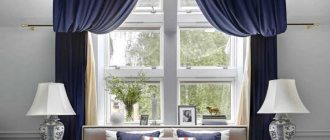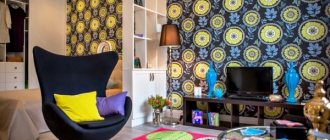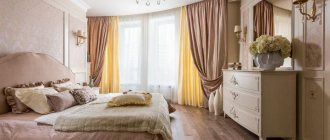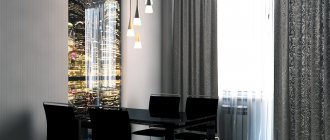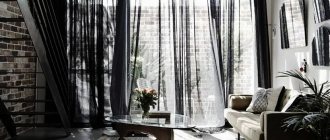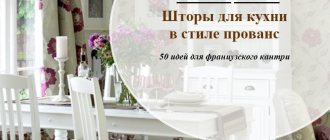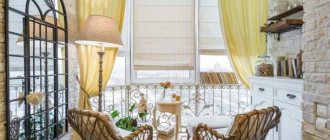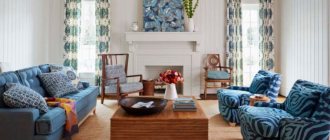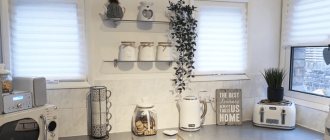Help the site, share with friends:
Finally, a lambrequin can put the finishing touches on a lengthy renovation of a living room.
It is he who is able to give a set of curtains true nobility, sophistication, and, if necessary, update old curtains, or even adjust the existing window parameters.
At the same time, the main function that lambrequins perform in the living room is to decorate the interior and make it truly chic.
Main types of lambrequins
Today the following types of this decoration are known and widely used:
- soft versions of lambrequins (using natural or synthetic fabrics);
- rigid, allowing you to completely hide the attachment points and cornices (wooden or plastic frames are used), they are also called bandeaus;
- combined varieties.
There are also beautiful curtains with the inclusion of openwork elements, for the production of which they began to use laser cutting.
Fabrics
Designers advise choosing lambrequins from the same fabrics as curtains. This way the interior will look more harmonious.
However, if different models are used in window design, it is necessary to maintain consistency in texture and print.
Here are the fabrics that are most often used for sewing lambrequins:
- Veil. The material has the ability to dim light. Its other advantages are lightness, variety of colors, resistance to fading, and good drapery.
- Organza. Made from silk, polyester or viscose fibers. May have a matte or shiny surface. Decorated with etched, printed or embroidered designs. Features: rigid texture, transparency, excellent light transmission, low weight.
- Felt. It can be of natural or artificial origin. An adhesive layer is required to attach to the cornice. The advantages of felt are high density, a wide range of shades, and resistance to ultraviolet radiation. The downside is that washing is useless.
- Chiffon. Advantages: lightness, naturalness, excellent compatibility with curtains of different models, rich color palette, versatility (chiffon curtains can be used in any interior style).
- Atlas. Satin fabric is based on silk threads, so it has a noble shine and expressive colors. The material can also boast of good strength qualities, and also the fact that it is not afraid of pets. In addition, the dense texture will protect the room from direct sunlight.
What forms of drapery are there?
The fabric in curtains can be laid in different ways. Depending on this, there are several options for lambrequin curtains:
- the most common remain svagi, when semicircular elements (2 or 3) are obtained, laid in soft folds (symmetrical or one-sided, plain or contrasting);
- in the form of throws (half-swag), this is when the fabric is thrown over the eaves and has freely hanging edges;
- mold method: the material is folded to form an acute angle (more often used to decorate several adjacent windows on the same wall);
- in the jabot style (de jabot), when on the side there is a wide strip of fabric with beveled edges, somewhat reminiscent of a jabot;
- in the form of a tie, somewhat reminiscent of the previous version, but narrower, when the vertical folds are made as if on top of each other;
- in the form of a cascade made of trapezoid-shaped fabric, falling in rather wide folds, it is made along the entire perimeter, thus emphasizing the boundaries of the opening;
- in the form of a puff (vertical even folds, reminiscent of a pigtail);
- less commonly used bells, when dense fabric is laid in the shape of a cone (it is difficult to achieve such a laying with light fabrics);
- laying in the form of festoons, reminiscent of swags, but wider flounces, more appropriate for large living rooms and high ceilings.
All possible options for photo curtains with a lambrequin give a clear idea of the appearance of all the listed versions.
Mounting methods
A soft small lambrequin can be sewn directly to the top edge of the curtain.
However, in most cases, it is hung on a special additional cornice, which is approximately 15 cm longer than the main one and is attached to the wall or ceiling so that its load-bearing part protrudes in front of the main cornice.
What materials can be used?
When sewing curtains, different materials and their combinations are used, observing the color scheme and their texture. Can be found:
- light voile curtains with an almost weightless and elegant structure, translucent and beautiful folds;
- sewn from organza, which also drapes easily and holds its shape;
- nylon options, quite durable and light, but difficult to sew yourself;
- felt as a modern element of openwork decor, which is becoming increasingly popular;
- translucent and lightweight chiffon, characterized by bright and rich colors;
- shiny satin, quite dense texture, holding any shape well;
- jacquard with its relief patterns, visually reminiscent of a tapestry;
- linen fabrics with a matte sheen that fit well into all modern or country styles;
- velvet lambrequins, more used in curtains for the hall, giving maximum luxury and sufficient solidity.
Recommendations
Having decided to purchase a lambrequin, you should familiarize yourself with the recommendations given by experts:
- Soft models need frequent washing, while hard ones can only be cleaned with a vacuum cleaner.
- When purchasing combined elements, the soft parts should be removable so that there are no difficulties with maintenance.
- Be sure to read the instructions included with the product.
- Before removing the curtains for cleaning, it is wise to take photographs. This will help in the future to correctly return them to the cornice.
Lambrequin is an important interior detail. You need to choose it wisely. In this case, you should be guided by the style, architectural features of the room and personal preferences.
Decor and decoration options
Designers know many techniques that allow them to create truly beautiful and unique jewelry: tassels made of threads, beads, bugles, rhinestones and other unusual elements, floral patterns, inclusions of braid, fringe, etc.
New curtains with flowers based on photo printing began to appear more often, matching the walls of the room and the interior.
Winning ideas
The following combinations are considered the most popular and universal:
- Matte tulle with a discreet pattern and a two-tone lambrequin with swags and jabot, combining a shade similar to the base and a contrasting tone.
- A short curtain with floor-length curtains and an elongated “top”.
- The combination of warm bright colors in the curtain composition.
- Combining simple transparent tulle with straight curtains, bamboo curtains and matching lambrequins.
Tips for choosing a lambrequin
When choosing one option or another, you will have to take into account several nuances and secrets:
- Due to the fact that such decorative elements can visually “conceal” height, they are suitable primarily in rooms with a high ceiling. If the height is less than 2.5 m, it is better to focus on vertical patterns on the fabric.
- Standard lambrequins in curtain sets usually have a height of about 40 cm. If you want to reduce the size, you should first try on a smaller option to see how it will look in a particular case.
- In small living rooms, options with a small number of flounces are more suitable, and voluminous lambrequins with a large number of elements are preferable in large halls.
- On the sunny side, it is better to choose heavier and denser materials for curtains, but in other cases, organza or veil are perfect for both ready-made curtains and for sewing a lambrequin on your own.
- If a lambrequin is selected for 2 adjacent windows at once, it is better to choose a mold shape that emphasizes the boundaries of the two openings. This will help add extra space.
- When decorating a window with a balcony, you should take a closer look at asymmetrical shapes, provided that they do not block free access.
- When designing a small window, it is taken into account that a fully open opening visually enlarges the window. Therefore, it is not recommended to go below the window opening. Throws, cascades or asymmetrical options with fringe and tassels are appropriate here.
- In the case of a narrow window, on the contrary, it is advisable to partially cover the opening with a lambrequin. With high ceilings, models containing folds will look most impressive.
- In any case, rigid options will help to “add” centimeters to the actual height.
- Corner windows love symmetrical design. A tie or chill necklace in the corner of the room is appropriate here.
- To ensure that the design does not look too busy, the lambrequin cannot be longer than 1/5 of the total length of the curtain.
- In large rooms, large details, dark shades, and horizontal patterns are suitable.
- Small spaces require choosing lighter pastel colors, preferably vertical patterns.
In a small kitchen, for example, it is better to hang small compositions or use curtains without a lambrequin at all.
When choosing the design of curtains, it is worth taking into account the general style of the decor so that there is no feeling of incompleteness or, conversely, excessive pomp.
Note!
Curtains with eyelets in a modern interior. Real examples of curtain design and decoration (135 photos)
- Bamboo curtains: design features, installation options, photos of modern design (100 photos)
- Light green curtains - 120 photos of the most beautiful design and interior design options
Colors
As a rule, the cut option depends on the existing or planned design of the room, window geometry, etc. But there are no restrictions on color.
This season, a number of tones are most relevant:
- UV. Recommended companion colors for it are soft green, lilac, blue, yellow, purple, terracotta. Golden cords will ideally complement the composition.
- Niagara. The richness and delicacy of the tone will be perfectly emphasized by pastel pink, blue, green or chocolate colors.
- Yellow primrose. This very positive color looks great in tandem with azure, lilac, scarlet, and coffee palettes.
- Lapis lazuli. The shade attracts with its purity and richness. It goes well with the previous color scheme, as well as with muted tones of pink, blue, and brown.
- Flame. Warm and rich tone. Ideal for complementary details as it creates a stylish, vibrant energy. Combines with white, burgundy, graphite, black, chestnut, sapphire.
- Paradise Island. Pale turquoise can be combined with the entire blue palette. He also feels great in the company of white, green, lilac, beige and gray colors.
- Hazelnut. The walnut color scheme can play a background role for pastel shades of green and orange, brown and cornflower blue.
- Greenery. Suitable for combinations with lilac, pink, blue.
Presence of folds
The procedure for making a lambrequin with folds becomes more complicated. When cutting out parts, they do not use a simple linear pattern. A trapezoid is cut out of the fabric. The base of the figure is equal to the length of the cornice.
The bottom edge is processed in the usual way. A curtain tape with cords is attached to the top to make draperies. By tightening the ropes, the desired position of the assemblies is formed. This allows the product to look impressive.
There is no need to be afraid to take on sewing curtains and lambrequins. If you choose simple models and follow the instructions while working, the process will be enjoyable and the result will please you.
Lightness of openwork patterns
A type of rigid lambrequins is openwork. They are perfectly combined with windows of different sizes and configurations, giving the curtain composition lightness and weightlessness. There can be either harmonious or contrasting shades to the main color of the curtains.
They are made of dense fabric reinforced with a non-woven base with an adhesive layer, or felt. In industrial conditions, openwork patterns are cut using a laser, which simultaneously processes and seals the edges of the cuts.
If you have patience, you can make this exquisite decoration for curtains at home with your own hands.
Note!
- Tulle for the living room: 135 photos and videos of examples of stylish window design in a modern interior
- IKEA living rooms - 165 photos and videos describing real options for using ideas from IKEA for living rooms
- Living room in Khrushchev - 165 photos and video description of how to decorate a typical living room in Khrushchev
The contrasting filigree lambrequin looks especially elegant against the background of smooth and unpretentious plain-colored curtains.
Soft
Allows you to completely transform the room; soft, flowing fabrics of different textures and patterns are used, which flow in smooth waves from the ceiling. Among soft draperies there are:
Note!
- How to hang curtains beautifully - instructions for installing types of curtains. Types of fastening, materials and colors (photo + video)
- Curtains with eyelets - advantages and disadvantages of eyelets, features of installing curtains. Selection of eyelet materials and fabric for curtains (photo + video)
- Curtains for the balcony: TOP-150 photos and videos of curtain designs for the balcony. Application and necessity of curtains on the balcony, choice of fabric and colors
Coquille
As a rule, a long (full height of the curtains or from the ceiling to the floor) piece of fabric with folds - waves. It can be located in the middle of the curtains, visually separating them or when combining two windows located next to each other.
The small wall between the windows is hidden by elegant drapery.
Tools, patterns
There is no special pattern for a simple lambrequin. It is enough to know the length of the cornice and make extra allowances for beautiful drapery. To make a bandeau, draw the desired pattern on paper.
- Provence curtains - design ideas and review of ideal combinations of curtains in a rustic style (110 photos and videos)
- Yellow curtains: types, fabrics, shades and use in the interior. 115 photo examples of ideal combinations
- Openwork curtains: beautiful models, original selection ideas and application options (110 photos and videos)
In addition to the fabric, you will have to prepare:
- curtain tape;
- threads;
- bias tape.
You may also need interlining, additional fabric for lining, pins, and decorative elements (fringe, cords, beads).

